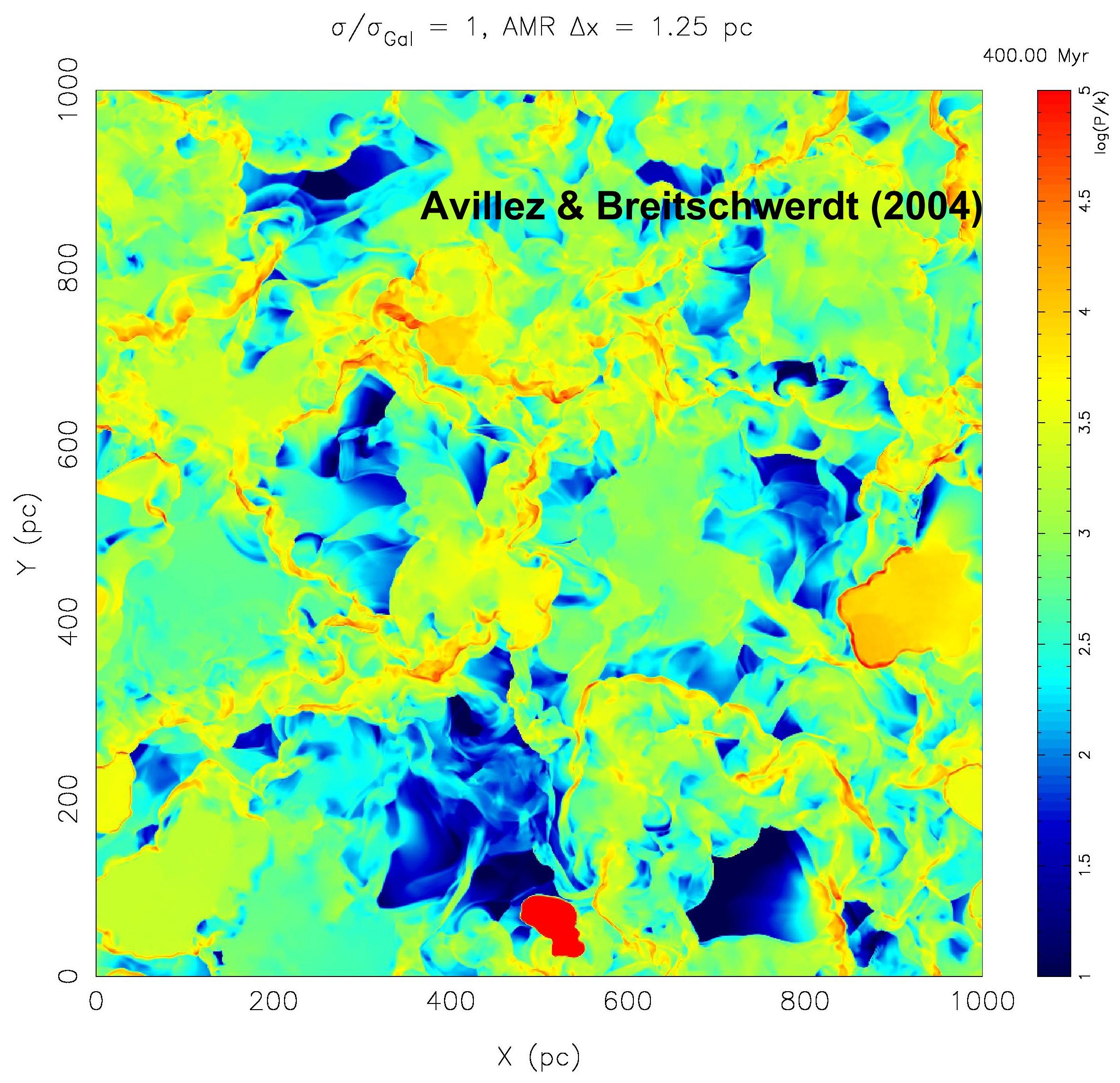
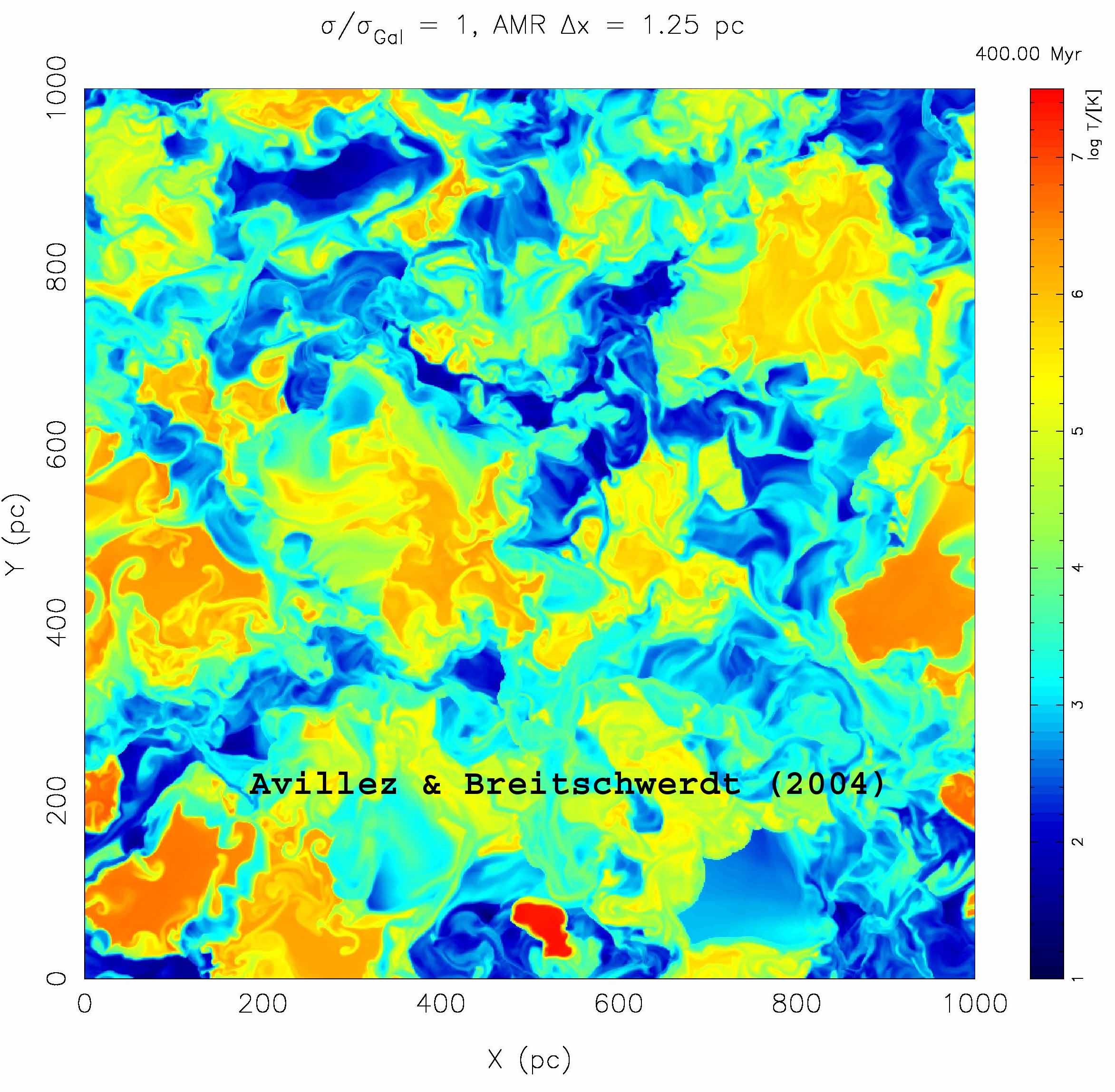
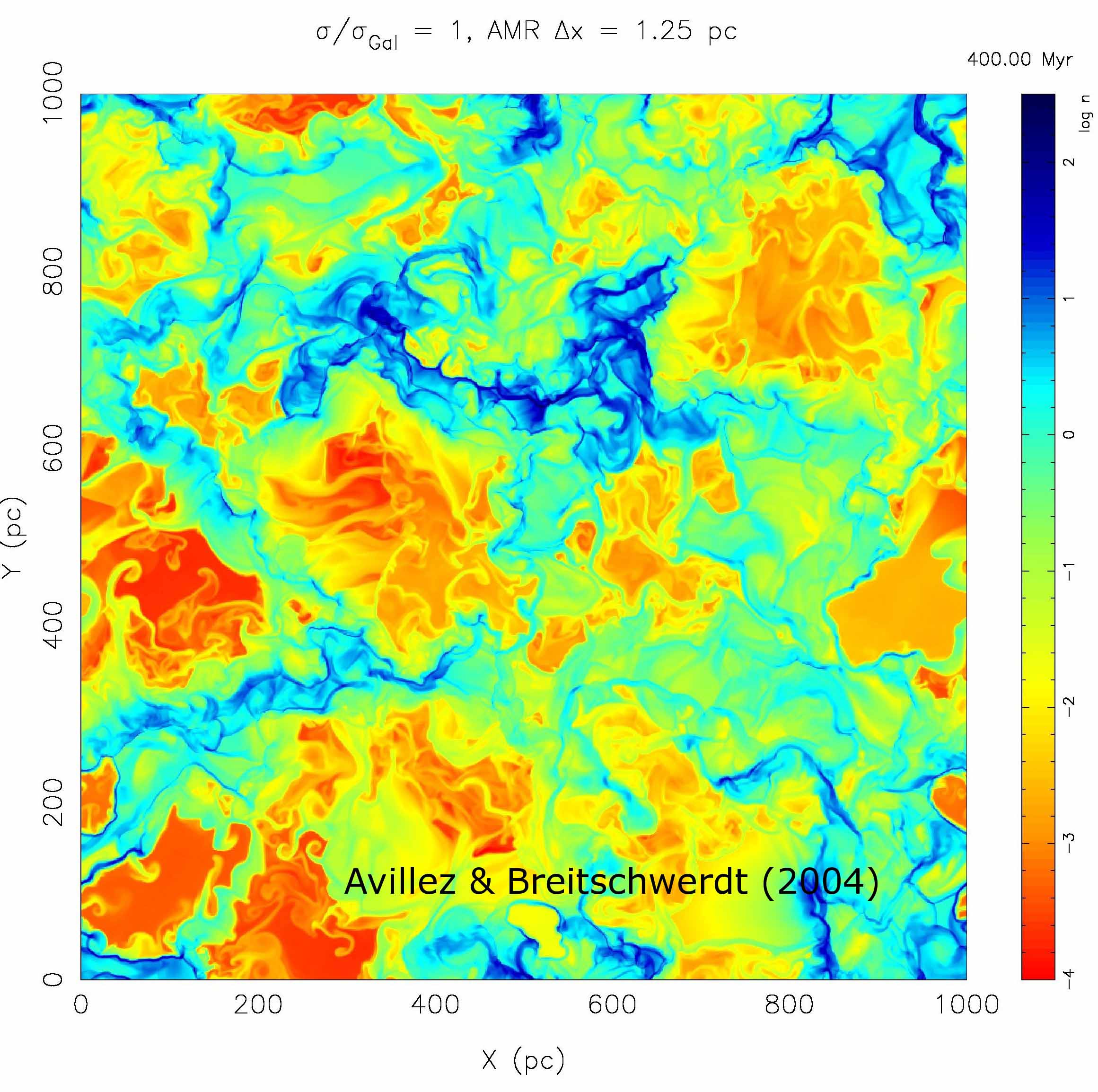 Fig 1.: ISM
pressure, temperature and density (clockwise from top left) from 3D
high resolution simulations on parallel machines for sections through
an area of the Milky Way disk after 400 million years of
evolution. The structure of the ISM is driven by supernova explosions,
occurring at the observed rate (for details see Avillez &
Breitschwerdt 2004), which generate a substantial amount of turbulence
due to shear flows. The x- and y-axis range stretch out to 1000 pc and
the
colour coding is (from bottom to top of the bar): 10-1
< P/k < 105K
cm-3 (top left), 101
< T < 107.5 K (top right), 10-4<
n < 102.5 cm-3
(bottom left).
Fig 1.: ISM
pressure, temperature and density (clockwise from top left) from 3D
high resolution simulations on parallel machines for sections through
an area of the Milky Way disk after 400 million years of
evolution. The structure of the ISM is driven by supernova explosions,
occurring at the observed rate (for details see Avillez &
Breitschwerdt 2004), which generate a substantial amount of turbulence
due to shear flows. The x- and y-axis range stretch out to 1000 pc and
the
colour coding is (from bottom to top of the bar): 10-1
< P/k < 105K
cm-3 (top left), 101
< T < 107.5 K (top right), 10-4<
n < 102.5 cm-3
(bottom left).
The key to this change in paradigm lies in the nature of
compressibility of the ISM gas and its high Reynolds number (105
- 107). The flow is driven by supernova
explosions from massive stars with more than 8 solar masses. Thus the
flow, as by the way most flows in nature, is highly turbulent. Consider
walking down a street surrounded by high buildings, and you will
experience winds gusting down on the sidewalk. The reason is that a
turbulent boundary layer is generated by the air flow, which in turn
leads to the generation of vorticity (rotation of velocity field,
curl(u)) and
hence to turbulent eddies oozing out of the boundary layer.
The reason that flows can become turbulent lies in the
non-linear nature of the Navier-Stokes equation, Du/Dt
=-∇(P/ρ)+ ν ∇2u,
notably in the term (u∇)u (where ν is the kinematic
viscosity of the flow). Taking the curl of this equation and using the vector
identity ∇(u2/2)=(u ∇)u+u x ω, we obtain the vorticity equation Dω/Dt = (ω
∇)u + ν ∇2ω, where D/Dt is the usual convective derivative. The interpretation of
this equation is straightforward. But first consider the
angular momentum of a spherical blob: H = 1/2 Iω, where I is
the moment of inertia. Conservation of angular momentum yields DH/Dt
= τv, where τv is the viscous torque acting on the blob. The left hand side consists
of the terms I Dω/Dt + ω DI/Dt, and thus we
obtain I Dω/Dt = -ω DI/Dt + 2 τv. An increase in vorticity can therefore be due to the stretching of the
blob, e.g. deforming it from a spherical into a cigarlike shape, thus
decreasing its moment of inertia.This is called vortex stretching.
A familiar example may be a tornado, in which the rising air is
channeled into a hoselike configuration of converging streamlines, by
which vorticity may be considerably increased. Returning to the
vorticity equation, we now know that the first term on the rhs
corresponds to vortex stretching. This can also be seen if we look at
the velocity component parallel to the vortex tube, u//.
Thus (ω ∇)u// = |ω| du///ds, where ds is the line
element along the vortex tube. Now stretching corresponds to u//
increasing along s, which means du///ds > 0, which is equivalent to an increase in ω. The second term
on the lhs describes the transport of vorticity by diffusion. Just like
heat, vorticity can neither be created nor destroyed within the
interior of a flow, but vorticity can be advected and spread by
diffusion. This means that turbulence will cover a progressingly larger
and larger region. This should be kept in mind, when we now turn to the
evolution of supernova driven turbulence in the ISM.
We have performed high resolution numerical
simulations (Avillez & Breitschwerdt 2004, Astron.
Astrophys. 425, 899; 2005, Astron.
Astrophys. 436, 585) of the ISM (with and
without magnetic field) over an area of 1kpc x 1 kpc in the Galactic
disk, centred on the solar circle, and extending 10
kpc perpendicular to it on either side of the disk, in order
to capture the flow out of the disk, driven by supernova explosions. It
is found that this so-called galactic
fountain is essential for
regulating the disk pressure, and hence curtailing the volume factor to
lower values than previously assumed. The results show (see
figures) that the ISM is far from pressure equilibrium, in contrast to
what simple models predict. Even away from SN explosions, there are
pressure variations of more than an order of magnitude. We observed
that between 102 - 106 K,
the ISM is ram pressure dominated, with shear flows generating a
substantial amount of turbulence. And it is again the turbulence which
can suppress the cooling instability as the gas does not have enough
time to cool due to turbulent transport. It should be emphasized that
in our simulations, turbulence is generated self-consistently by
supernova induced shear flows, in contrast to other work, in which
turbulence is driven by artificial forcing.
Magnetic
Fields:
Large scale numerical
3D simulations with adaptive mesh refinement have also been performed
in the
ISM with an initially disk parallel magnetic field. Subsequently,
stellar winds and supernova explosions have been followed, and the
disruption of the upper disk and the evolution of superbubbles has been
followed closely at high resolution (Avillez & Breitschwerdt
2005).
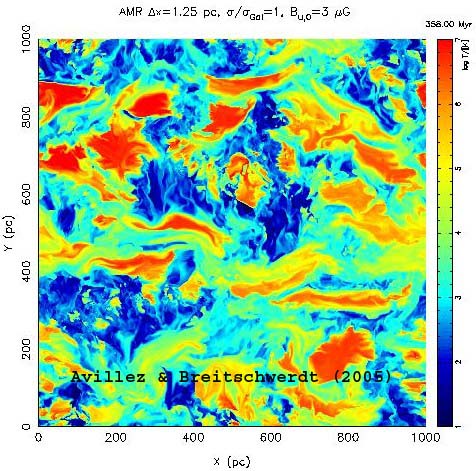
Fig 2: ISM temperature
distribution in a 1000 pc x 1000
pc region of the Milky Way centred on the solar circle after 400
million years of supernova explosion activity simulated on parallel
processors. The colour coding ranges from 10 K (blue) to 107
K (red).
The most noticeable
result is that supernova break-out of the disk does still occur even in
the presence of an obstructing, initially plane parallel to the disk
magnetic field, although the bubbles become now progressively elongated
(in direction of the field) due to magnetic tension forces (see red
regions in Fig. 2). Therefore the volume filling factors of the cold,
warm and hot gas are not much different from the pure hydrodynamical
case.
Cosmic Rays: see Section III.
Local
Bubble:
The Local Bubble (LB) is a region of roughly 200pc diameter in
the Milky Way disk, and stretching about 600 pc perpendicular to it. It
is deficient of HI and copiously emitting in EUV and X-rays. It
harbours small clouds, one of them being the so-called Local Cloud
(LIC), into which our solar system is embedded. Most likely,
the LB is a local superbubble created by successive supernova
explosions in the past. However, there is no direct evidence of a local
OB star association, which could have hosted supernova
progenitors. On the search for its origin, we have therefore analyzed
data of position, proper motions and radial velocities of stars using
the Hipparcos astrometry satellite data base, and found that a moving
group - the subgroup B1 from the Pleiades - was passing through the
region now occupied by the LB (Berghöfer &
Breitschwerdt 2002, Astron. Astrophys. 390,
299). During its passage, about 20 supernovae must have exploded,
according to the subgroup's missing stars, derived from a so-called
initial mass function (IMF) distribution for massive stars. A
more recent analysis by us (Fuchs et al. 2006, Mon. Not. Roy.
Astron. Soc. 373, 993) in a total region
of 400 pc diameter centred on the solar system has basically confirmed
these results, and has allowed us to determine the age of the LB
starting with its first explosion to have occurred about 14.5 million
years ago.
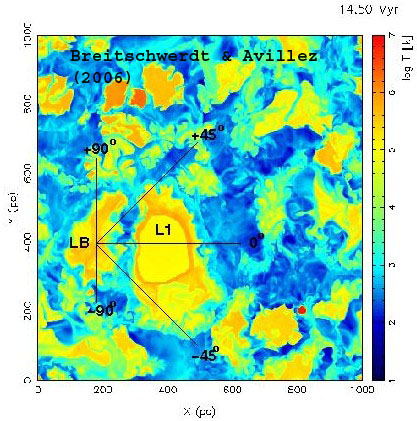
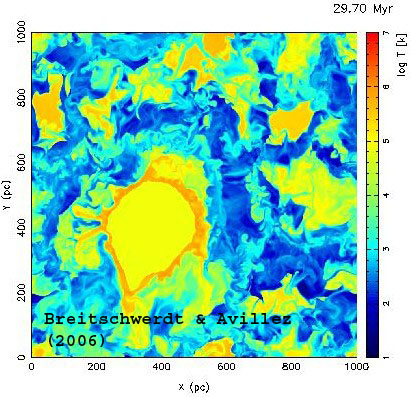
Fig. 3 (Left): The
present day temperature distribution
and extension of the Local Bubble (labeled LB) and the Loop I
superbubble (L1) in a section through the galactic midplane. The solar
system is located at the intersection of two lines of sight in the LB
drawn in the plot. (Right): same as before, but about 14 million years
from now, predicting that the LB will have been merged into the Loop I
superbubble. Note also that the LB temperature will be considerably
lower. The colour coding in both figures ranges from 10 K (blue) to 107
K (red).
In subsequent numerical high resolution 3D simulations, we
(Breitschwerdt & Avillez 2006, Astron. Astrophys.
Letters 452, L1) have put the LB and the
neighbouring superbubble Loop I for the first time into a pre-evolved
ISM (representing 200 million years of ISM evolution). In
addition, we used the time and exact locations of the supernova
explosions from our Hipparcos analysis, thus deriving the present day
LB structure, in agreement with observations, and predicting its future
merging with the Loop I bubble in about 14 million years (see Fig. 3).
Moreover, our studies can explain the low amount of the ion O5+
found from UV measurements with the FUSE satellite, which was
previously found difficult to reproduce by conductive interfaces. Our
results show a more realistic distribution of turbulent mixing layers,
while conduction fronts seem to be less important in the ISM.
 Fig 1.: ISM
pressure, temperature and density (clockwise from top left) from 3D
high resolution simulations on parallel machines for sections through
an area of the Milky Way disk after 400 million years of
evolution. The structure of the ISM is driven by supernova explosions,
occurring at the observed rate (for details see Avillez &
Breitschwerdt 2004), which generate a substantial amount of turbulence
due to shear flows. The x- and y-axis range stretch out to 1000 pc and
the
colour coding is (from bottom to top of the bar): 10-1
< P/k < 105K
cm-3 (top left), 101
< T < 107.5 K (top right), 10-4<
n < 102.5 cm-3
(bottom left).
Fig 1.: ISM
pressure, temperature and density (clockwise from top left) from 3D
high resolution simulations on parallel machines for sections through
an area of the Milky Way disk after 400 million years of
evolution. The structure of the ISM is driven by supernova explosions,
occurring at the observed rate (for details see Avillez &
Breitschwerdt 2004), which generate a substantial amount of turbulence
due to shear flows. The x- and y-axis range stretch out to 1000 pc and
the
colour coding is (from bottom to top of the bar): 10-1
< P/k < 105K
cm-3 (top left), 101
< T < 107.5 K (top right), 10-4<
n < 102.5 cm-3
(bottom left). 



